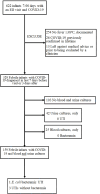Assessing the Risk of Urinary Tract Infection and Invasive Bacterial Infection in Febrile Infants Aged 7-90 Days With COVID-19
- PMID: 40385929
- PMCID: PMC12084670
- DOI: 10.7759/cureus.82405
Assessing the Risk of Urinary Tract Infection and Invasive Bacterial Infection in Febrile Infants Aged 7-90 Days With COVID-19
Abstract
Introduction Concomitant urinary tract infection (UTI) or invasive bacterial infection (IBI) in previously healthy, well-appearing febrile infants with COVID-19 is low. We sought to review the rates of UTI and IBI in all febrile infants with COVID-19 presenting to community emergency departments (EDs). Methods We retrospectively reviewed infants aged 7-90 days with COVID-19 from July 1, 2020, to August 31, 2022, who had an ED visit. Infants without fever or with COVID-19 more than seven days prior to the index ED visit were excluded. We collected data on blood, urine, and cerebrospinal fluid (CSF) culture results. UTI, bacteremia, and bacterial meningitis were defined by culture review as per prior standards. Results We included 622 infants, of whom 329 were febrile. Older infants and those presenting later in the pandemic had lower rates of complete evaluation. Of the 201 infants with urine collected, four (2%) had a UTI. Of the 184 infants with blood cultures obtained, 19 (10.3%) had contaminated blood cultures. One of the 159 infants (0.6%) with both blood and urine collected had an Escherichia coli bacteremic UTI. Only 12 infants had CSF obtained; however, no infants received treatment for bacterial meningitis. Factors associated with UTI were higher white blood cell (p=0.001) and absolute neutrophil counts (p=0.036), and abnormal urinalysis (UA) and urine microscopy (p<0.001). Conclusions Febrile infants with COVID-19 are at low risk for UTI and even lower risk for IBI. We recommend, at a minimum, that all febrile well-appearing infants aged 7-60 days with COVID-19 be evaluated for concomitant bacterial infections with a UA with microscopy.
Keywords: bacteremia; bacterial meningitis; covid-19; febrile infant; urinary tract infection.
Copyright © 2025, Greenhow et al.
Conflict of interest statement
Human subjects: Consent for treatment and open access publication was obtained or waived by all participants in this study. Kaiser Permanente Northern California Institutional Review Board issued approval 00001045. Animal subjects: All authors have confirmed that this study did not involve animal subjects or tissue. Conflicts of interest: In compliance with the ICMJE uniform disclosure form, all authors declare the following: Payment/services info: The study was supported by the Garfield Memorial Fund. Financial relationships: All authors have declared that they have no financial relationships at present or within the previous three years with any organizations that might have an interest in the submitted work. Other relationships: All authors have declared that there are no other relationships or activities that could appear to have influenced the submitted work.
Figures
Similar articles
-
Febrile Infants ≤60 Days Old With Positive Urinalysis Results and Invasive Bacterial Infections.Hosp Pediatr. 2020 Dec;10(12):1120-1125. doi: 10.1542/hpeds.2020-000638. Hosp Pediatr. 2020. PMID: 33239319 Free PMC article.
-
Trends in Prevalence of Bacterial Infections in Febrile Infants During the COVID-19 Pandemic.Pediatrics. 2022 Dec 1;150(6):e2022059235. doi: 10.1542/peds.2022-059235. Pediatrics. 2022. PMID: 36353853
-
Vesicoureteral Reflux.2024 Apr 30. In: StatPearls [Internet]. Treasure Island (FL): StatPearls Publishing; 2025 Jan–. 2024 Apr 30. In: StatPearls [Internet]. Treasure Island (FL): StatPearls Publishing; 2025 Jan–. PMID: 33085409 Free Books & Documents.
-
Diagnosis of urinary tract infection in infants under 3 months with fever without a source: reliability of urinalysis and urine culture.Bol Med Hosp Infant Mex. 2023;80(5):288-295. doi: 10.24875/BMHIM.23000030. Bol Med Hosp Infant Mex. 2023. PMID: 37963294 Review. English.
-
Prevalence of Bacterial Meningitis Among Febrile Infants Aged 29-60 Days With Positive Urinalysis Results: A Systematic Review and Meta-analysis.JAMA Netw Open. 2021 May 3;4(5):e214544. doi: 10.1001/jamanetworkopen.2021.4544. JAMA Netw Open. 2021. PMID: 33978724 Free PMC article.
References
-
- SARS-CoV-2 among infants <90 days of age admitted for serious bacterial infection evaluation. Paret M, Lalani K, Hedari C, et al. Pediatrics. 2021;148:0. - PubMed
LinkOut - more resources
Full Text Sources

